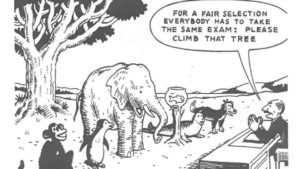Differential Learning- Four Key Principles of Tomlinson: One Size does NOT Fit All!
Anika H. Ahmed, MD
 It can get very challenging for an instructor when he or she has to cater for students at different levels in the same classroom. This is a situation faced by many educationists on a daily basis and it becomes especially challenging when a certain standardized curriculum needs to be followed. A particular group of students may not only have different learning styles – visual, auditory, written, or kinesthetic that leads to a different learning process, but could also be at different intellectual levels.
It can get very challenging for an instructor when he or she has to cater for students at different levels in the same classroom. This is a situation faced by many educationists on a daily basis and it becomes especially challenging when a certain standardized curriculum needs to be followed. A particular group of students may not only have different learning styles – visual, auditory, written, or kinesthetic that leads to a different learning process, but could also be at different intellectual levels.
For example, some in the same group may be totally unfamiliar with the content, others somewhat familiar and even others very familiar with content, possibly even beyond the level of instruction.
A well experienced instructor will surely follow the four key principles of Tomlinson, to differentiate instruction and provide learning through four different ways:
- Content- what the students sees, hears, reads, or does in class.
In other words what kind of material is given out catering for the four senses- audio, visual, written words to read and move around. Bloom’s Taxonomy can be applied here that gives a classification of six different intellectual levels namely remembering, understanding, applying, analyzing, evaluating, and creating. Students on the lower end of the spectrum that are unfamiliar with a lesson could be asked to complete tasks on the lower levels- remembering and understanding. On the other hand, students with somewhat mastery over the introduced content could be asked to apply and analyze the content and the remaining students that have higher levels of mastery could be asked to completed tasks in the context of evaluating and creating on their own.
- Process- how the students, based on their individual learning styles, make use of their four senses: visual, auditory, kinesthetic, and through words.
This also focuses on the fact that not all the students require the same support from the instructor and students could choose to work in pairs, small groups or even individually. Each student shall process the material given to them and shall channel it out with their unique individual, pair, or group production. Examples of such differentiating activities are:
- Match vocabulary words to their meanings.
- Process a text and answer related questions.
- Simulate a situation that happened to a character in the story and a different outcome.
- Differentiate fact from opinion in the story and give your interpretation.
- Identify the tone, writer’s position and provide evidence to support this.
- Make a presentation summarizing the lesson.
Some examples of process are providing students with written material in the case of visual and word learners, letting auditory learners listen to audio recordings, and giving kinesthetic learners a chance to complete an interactive assignment.
Teachers can facilitate student learning by offering support based on individual needs
- Product- this is what the student is able to deliver on, at the end of a lesson to show how much he or she has absorbed and mastered the content given.
Product could be in the form of tests, projects, reports or individual or group presentations or activities. For example, a book report, oral presentation, illustrations of a story, etcetera.
- Learning Environment- the key to success here is with having a friendly, flexible classroom, both in physical and psychological aspects, that provides a supportive learning environment, allowing students to have individual, paired, or grouped activities.
For example, break students into groups according to their learning styles and levels, allow students to perform individually, if they so desire and provide quiet spaces with no distraction, like break out rooms on zoom, when in an on line virtual learning environment.

provigil over the counter buy modafinil generic provigil 100mg order generic modafinil 200mg provigil 100mg tablet modafinil cheap modafinil where to buy
Your comment is awaiting moderation.